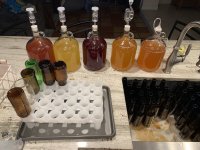Fern0022
Active Member
- Joined
- Aug 27, 2021
- Messages
- 25
- Reaction score
- 2
I brewed 5gal of cider in a single carboy. Then I added fresh pressed fruit juice to five separate 1gal carboys and topped each of them off with the fermented cider. They all experienced a healthy secondary fermentation, have cleared beautifully, and taste great. But I have no idea how to calculate the abv of these finished ciders due to the changes in water volume & gravity readings during secondary. I did however keep accurate notes.
So if there is anyone with superior knowledge who also happens to like a good puzzle, please help!
5gal Recipe:
5 gal Nature’s Nectar Apple Juice
1 packet Mangrove Jack Cider Yeast M02
5 tsp yeast nutrient
2.5 tsp pectic enzyme
OG: 1.047
FG: 1.00 (~6.17% ABV)
1gal Secondary Recipes:
Blackberry:
-30oz blackberry juice
-90oz fermented cider
-New OG: 1.08
-FG: 1.00
Raspberry:
-22oz raspberry juice
-106oz fermented cider
-New OG: 1.06
-FG: 1.00
Strawberry:
-20oz strawberry juice
-108oz fermented cider
-New OG: 1.04
-FG: 1.00
Cherry:
-22oz cherry juice
-106oz fermented cider
-New OG: 1.08
-FG: 1.00
Peach:
-16oz peach juice
-112oz fermented cider
-New OG: 1.02
-FG: 1.00
So if there is anyone with superior knowledge who also happens to like a good puzzle, please help!
5gal Recipe:
5 gal Nature’s Nectar Apple Juice
1 packet Mangrove Jack Cider Yeast M02
5 tsp yeast nutrient
2.5 tsp pectic enzyme
OG: 1.047
FG: 1.00 (~6.17% ABV)
1gal Secondary Recipes:
Blackberry:
-30oz blackberry juice
-90oz fermented cider
-New OG: 1.08
-FG: 1.00
Raspberry:
-22oz raspberry juice
-106oz fermented cider
-New OG: 1.06
-FG: 1.00
Strawberry:
-20oz strawberry juice
-108oz fermented cider
-New OG: 1.04
-FG: 1.00
Cherry:
-22oz cherry juice
-106oz fermented cider
-New OG: 1.08
-FG: 1.00
Peach:
-16oz peach juice
-112oz fermented cider
-New OG: 1.02
-FG: 1.00





